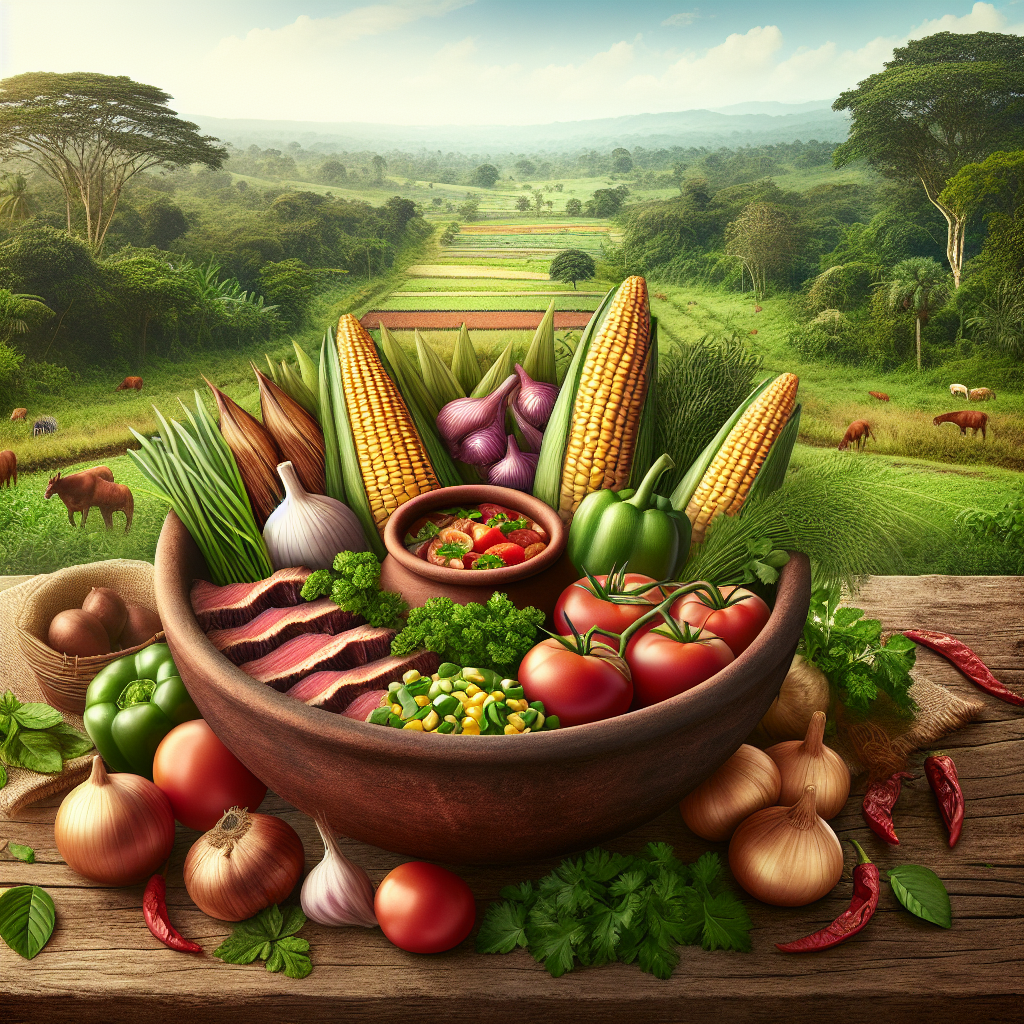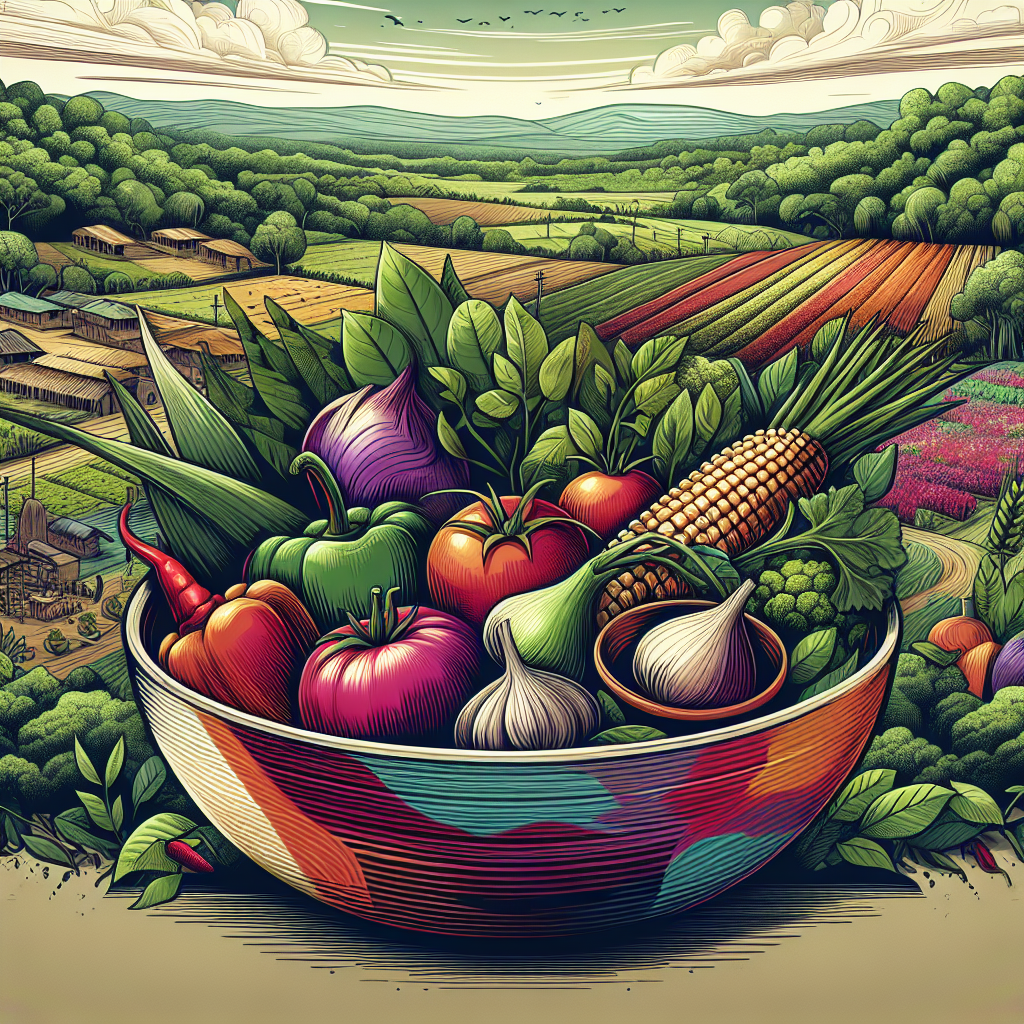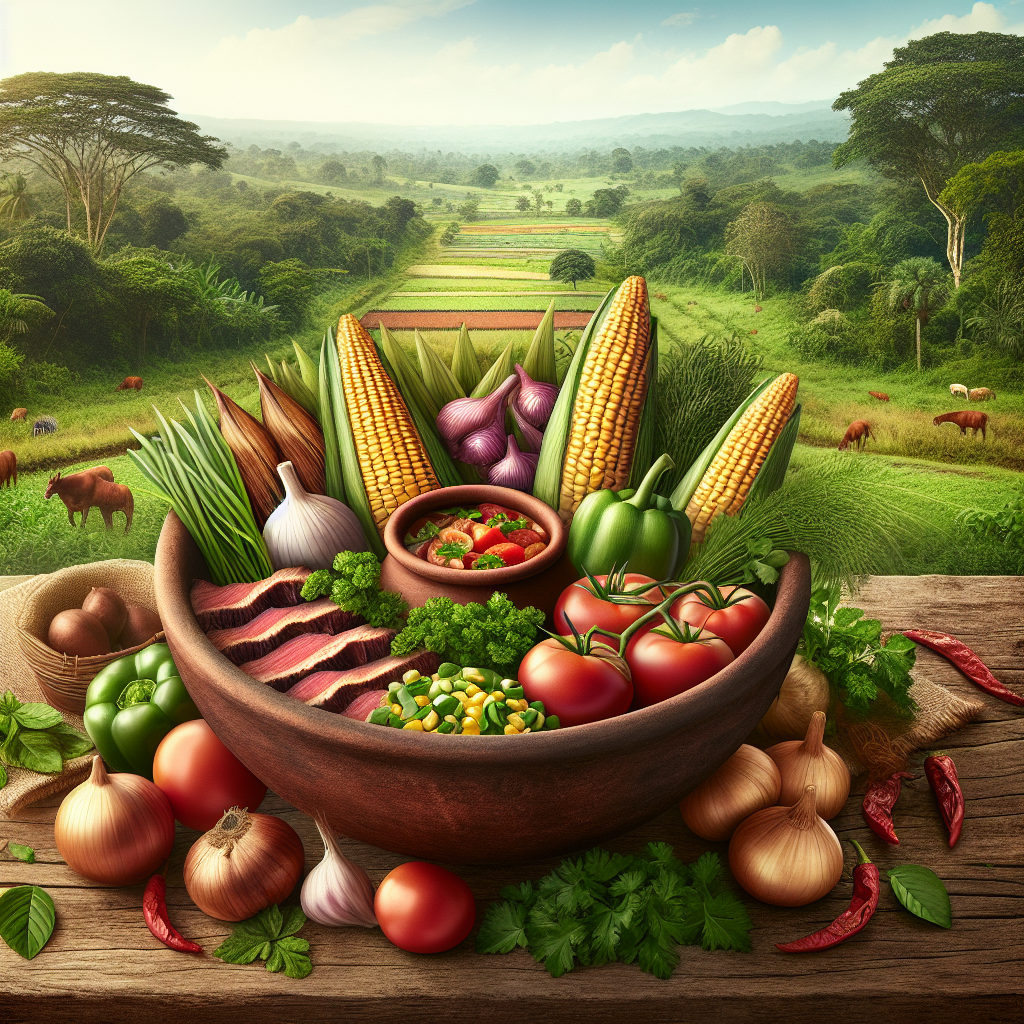Are you a food enthusiast looking to explore the vibrant flavors of Nicaraguan cuisine? If so, you’re in for a treat! In this article, we will introduce you to a variety of traditional Nicaraguan dishes that not only tantalize your taste buds but also reflect the country’s admirable dedication to sustainable agriculture. From mouthwatering gallo pinto, a combination of rice and beans served with a medley of fresh vegetables, to the delectable vigorón, a hearty dish featuring yuca, pork, and cabbage, Nicaraguan cuisine has much to offer in terms of both flavor and eco-consciousness. So, prepare to embark on a culinary journey that brings together the best of Nicaragua’s culinary heritage and sustainable farming practices.
Traditional Nicaraguan Dishes
Nicaraguan cuisine is known for its rich and vibrant flavors, influenced by indigenous and Spanish traditions. Many traditional Nicaraguan dishes reflect the country’s commitment to sustainable agriculture by utilizing locally sourced ingredients and traditional cooking methods. Let’s explore some of these delicious dishes and how they showcase Nicaragua’s dedication to sustainability.
Indio Viejo
One iconic Nicaraguan dish that showcases sustainable agriculture is Indio Viejo. This hearty stew is made with shredded beef or pork, vegetables, and a unique ingredient called masa de maíz, which is a dough made from cornmeal. The corn used in Indio Viejo is typically locally grown and ground, ensuring the freshest flavors and supporting local farmers. By using ingredients that are readily available in Nicaragua, Indio Viejo promotes the use of local produce and reduces the carbon footprint associated with transporting ingredients from long distances.
Nacatamal
Another traditional Nicaraguan dish that highlights sustainable agriculture is Nacatamal. Similar to a tamale, Nacatamal is made with a corn-based dough that is filled with seasoned pork, vegetables, and other ingredients. The corn used in Nacatamal is typically locally grown and ground, supporting small-scale farmers and ensuring the use of fresh and high-quality ingredients. Additionally, Nacatamal incorporates traditional cooking techniques, such as wrapping the tamale in banana leaves, which adds another layer of sustainability by utilizing biodegradable materials.
Gallo Pinto
Gallo Pinto is a staple dish in Nicaragua, often enjoyed for breakfast or as a side dish. This flavorful combination of rice and beans is seasoned with onions, peppers, and spices, creating a delicious and satisfying dish. The beans used in Gallo Pinto are usually locally sourced, supporting small-scale farmers and reducing the environmental impact associated with large-scale agriculture. Additionally, Gallo Pinto is a great example of food waste reduction, as it can be made using leftover rice and beans from previous meals.
Vigorón
Vigorón is a traditional Nicaraguan dish that combines yuca, chicharrones (crispy pork rinds), and curtido (a tangy cabbage and tomato salad). The yuca used in Vigorón is often sourced from local farmers, ensuring the freshest and most sustainable ingredients. This dish not only showcases the flavors of Nicaragua but also supports local agriculture by promoting the consumption of fresh and locally grown produce.
Plant-based Nicaraguan Dishes
In recent years, plant-based diets have gained popularity worldwide due to their health and environmental benefits. Nicaragua offers a range of delicious plant-based dishes that showcase the country’s commitment to sustainable agriculture while catering to vegetarian and vegan preferences.
Nacatamal Vegetariano
Vegetarian versions of Nacatamal are becoming increasingly popular in Nicaragua. Instead of using meat, these vegetarian Nacatamales are filled with a variety of vegetables, including carrots, bell peppers, and onions. The masa dough used in vegetarian Nacatamales is still made from locally sourced corn, highlighting Nicaragua’s dedication to supporting local farmers and utilizing sustainable agricultural practices.
Gallo Pinto con Plátano Maduro
For plant-based options, Gallo Pinto can be prepared without the addition of any animal products. In this version, the rice and beans are cooked with onions, peppers, and spices, creating a flavorful and nutritious dish. This plant-based Gallo Pinto is often served with plátano maduro, or ripe plantains, which are a delicious and sustainable alternative to meat or dairy products.
Vigorón Vegano
Vegan Vigorón is another plant-based twist on the traditional dish. Instead of chicharrones, this version of Vigorón uses plant-based proteins such as tofu or tempeh to create a crispy and flavorful texture. The tangy cabbage and tomato salad, curtido, remains a key element of the dish, highlighting Nicaragua’s commitment to using fresh and locally sourced ingredients.

Dishes featuring Local Produce
Nicaragua boasts a diverse range of fruits, vegetables, and other crops due to its fertile land and tropical climate. Many traditional dishes in Nicaragua feature local produce, promoting the consumption of seasonal ingredients and supporting local farmers.
Tostones con Tajadas
Tostones con Tajadas is a popular Nicaraguan dish made with green plantains. The plantains are sliced and fried twice until they are crispy on the outside and soft on the inside. Tajadas, which are thinly sliced fried plantains, are served alongside the tostones, creating a delicious combination of textures. By using locally grown plantains, this dish supports small-scale farmers and reduces the carbon footprint associated with importing produce from other regions.
Sopa de Albóndigas de Cerdo y Yuca
Sopa de Albóndigas de Cerdo y Yuca is a hearty soup made with pork meatballs, yuca (cassava), vegetables, and flavorful spices. The use of pork and yuca highlights Nicaragua’s reliance on locally sourced ingredients. By incorporating these ingredients into traditional recipes, Nicaraguan cuisine supports sustainable agricultural practices and reduces the need for imported products.
Nacatamales de Cerdo
Nacatamales de Cerdo are traditional Nicaraguan tamales filled with seasoned pork, vegetables, and rice. These tamales are wrapped in banana leaves, giving them a unique flavor and aroma. The use of locally sourced pork and vegetables ensures freshness and supports local farmers. By relying on local produce, Nicaragua’s traditional dishes contribute to sustainable agriculture and the preservation of local flavors and traditions.
Traditional Nicaraguan Desserts
No culinary exploration of Nicaragua would be complete without trying some traditional Nicaraguan desserts. These sweet treats incorporate local ingredients and traditional recipes, providing a taste of Nicaragua’s commitment to sustainable agriculture.
Cajetas de Leche
Cajetas de Leche are sweet, caramel-like confections made with milk, sugar, and vanilla. This traditional Nicaraguan dessert showcases the country’s dedication to sustainability by utilizing locally produced milk and sugar. By supporting local dairy farmers and sugarcane growers, Nicaraguan cuisine incorporates ingredients that have a lower carbon footprint compared to imported alternatives.
Quesillos
Quesillos are a beloved Nicaraguan street food and dessert. They consist of a freshly made tortilla filled with salty cheese, pickled onions, and a drizzle of sour cream. The cheese used in quesillos is typically made from locally sourced milk, providing a rich and authentic flavor. This dessert represents Nicaragua’s commitment to utilizing local resources and supporting small-scale dairy farmers.
Tres Leches
Tres Leches is a decadent Nicaraguan dessert that consists of a sponge cake soaked in a mixture of three different kinds of milk: evaporated milk, condensed milk, and whole milk. The use of locally sourced dairy products ensures freshness and authenticity in this dessert. By incorporating locally produced milk, Tres Leches represents Nicaragua’s dedication to sustainable agriculture and supporting local dairy farmers.

Nicaraguan Beverages
Nicaragua offers a variety of traditional beverages that highlight the country’s commitment to local resources and sustainable agriculture. These beverages often feature ingredients such as corn, cacao, and fruits grown in the region.
Pinolillo
Pinolillo is a popular Nicaraguan beverage made from ground toasted corn, cacao, and spices. The toasted corn used in Pinolillo is typically sourced locally, supporting small-scale farmers and promoting the use of traditional ingredients. This drink represents Nicaragua’s commitment to preserving cultural heritage and sustainable agricultural practices.
Chicha
Chicha is a traditional fermented corn-based beverage that is enjoyed throughout Nicaragua. Made by fermenting corn with water and flavorings, such as pineapple or other fruits, Chicha reflects the use of local ingredients and traditional fermentation methods. By utilizing native corn varieties and promoting local agricultural practices, Chicha represents Nicaragua’s commitment to sustainable farming and preserving cultural traditions.
Cacao Drinks
Nicaragua is known for its high-quality cacao beans, which are used to produce flavorful and rich chocolate. Cacao drinks, such as hot chocolate or chilled cacao beverages, highlight Nicaragua’s dedication to sustainable agriculture and support for local cacao farmers. By promoting the consumption of locally grown cacao, Nicaragua contributes to the preservation of biodiversity and traditional farming practices.
The Connection to Sustainable Agriculture
Nicaragua’s commitment to sustainable agriculture goes beyond just utilizing locally sourced ingredients. The country actively supports small-scale farmers, promotes agroecology, and prioritizes the preservation of biodiversity.
Supporting Small-scale Farmers
Nicaragua recognizes the importance of supporting small-scale farmers who play a vital role in sustainable agricultural practices. By creating policies and programs focused on the development and success of these farmers, Nicaragua ensures that local communities have access to fresh, locally grown produce. This support empowers farmers to adopt sustainable farming techniques and strengthens the country’s food security.
Promoting Agroecology
Agroecology is an approach to farming that emphasizes the integration of ecological principles into agricultural practices. In Nicaragua, there is a growing movement towards agroecological practices, such as organic farming, permaculture, and crop diversification. By promoting agroecology, Nicaragua aims to reduce reliance on synthetic inputs, conserve natural resources, and build resilient farming systems that benefit both farmers and the environment.
Preserving Biodiversity
Nicaragua is home to a rich variety of plant and animal species, many of which are endemic to the country. The preservation of biodiversity is a priority in Nicaragua’s sustainable agriculture efforts. By promoting the use of native crops, supporting seed banks, and implementing conservation programs, Nicaragua aims to preserve genetic diversity and protect the ecosystems that support sustainable agriculture.

The Role of Organic Farming
Organic farming practices are an essential component of Nicaragua’s commitment to sustainable agriculture. By avoiding the use of synthetic fertilizers and pesticides, organic farming promotes soil health, reduces environmental pollution, and supports biodiversity.
Benefits of Organic Farming
Organic farming offers numerous benefits for both the environment and consumers. By relying on natural fertilizers and pest control methods, organic farmers minimize soil erosion, protect water quality, and reduce the environmental impact of agriculture. Additionally, organically grown crops are free from harmful residues, providing consumers with healthier and more nutritious food choices.
Organic Certification in Nicaragua
To ensure transparency and trust in the organic food market, Nicaragua has a robust system of organic certification. The certification process involves rigorous inspections and adherence to organic farming standards. By certifying organic farmers and products, Nicaragua provides assurance to consumers that the food they are purchasing meets strict organic guidelines, further promoting sustainable agriculture practices.
Encouraging Sustainable Fishing Practices
Nicaragua’s commitment to sustainable agriculture extends to its marine resources. The country recognizes the importance of responsible fishing practices and strives to protect marine ecosystems while supporting the livelihoods of fishing communities.
Promoting Responsible Fishing
Nicaragua promotes responsible fishing practices, such as size and catch limits, to ensure the sustainability of fish stocks. By implementing regulations and monitoring fishing activities, Nicaragua aims to prevent overfishing and protect vulnerable species. This commitment to responsible fishing helps maintain healthy marine ecosystems and supports the long-term viability of the fishing industry.
Protecting Marine Ecosystems
Nicaragua is home to diverse marine ecosystems, including coral reefs, mangroves, and seagrass beds. These ecosystems provide critical habitat for marine species and contribute to the overall health of the oceans. Nicaragua is actively involved in marine conservation efforts, including the establishment of marine protected areas. By protecting these ecosystems, Nicaragua safeguards biodiversity and ensures the sustainability of its fishing industry.

Efforts in Reducing Food Waste
Food waste is a significant global issue with substantial environmental and social implications. Nicaragua is taking steps to reduce food waste through various initiatives aimed at food recovery and community composting.
Food Recovery Initiatives
Nicaragua has implemented food recovery initiatives that aim to redistribute surplus food to those in need. These programs involve partnerships with food banks, shelters, and community organizations to collect and distribute excess food from farms, restaurants, and markets. By redirecting food that would otherwise go to waste, Nicaragua reduces food insecurity and minimizes the environmental impact of wasted resources.
Community Composting Programs
Composting is a sustainable waste management strategy that transforms food scraps and organic materials into nutrient-rich soil. In Nicaragua, community composting programs encourage residents and businesses to separate organic waste for composting instead of sending it to landfills. These programs educate and enable individuals to divert waste from disposal, reducing greenhouse gas emissions and enriching the soil for agricultural use.
Promoting Farm-to-Table Concept
The farm-to-table concept emphasizes the direct connection between farmers and consumers, promoting the consumption of locally sourced and seasonal produce. Nicaragua embraces this approach through farmers’ markets, direct sales, and farm-to-table restaurants.
Farmers’ Markets and Direct Sales
Farmers’ markets provide a platform for local farmers to sell their produce directly to consumers. These markets often feature a variety of fruits, vegetables, and other locally made products. By purchasing from farmers’ markets or participating in direct sales, consumers support local agriculture and have access to fresh and seasonal ingredients, reducing the carbon footprint associated with long-distance transportation.
Farm-to-Table Restaurants
Farm-to-table restaurants in Nicaragua prioritize sourcing ingredients from local farmers and producers. These restaurants celebrate the flavors of the region while supporting sustainable agricultural practices. By partnering with local farmers, farm-to-table restaurants contribute to the local economy, reduce food miles, and provide diners with a unique and sustainable culinary experience.
As you can see, Nicaragua offers a diverse range of dishes that not only tantalize the taste buds but also showcase the country’s commitment to sustainable agriculture. From traditional Nicaraguan dishes made with locally sourced ingredients to plant-based options that prioritize seasonal produce, Nicaragua’s culinary scene embodies the principles of sustainability. By supporting small-scale farmers, promoting organic farming, and encouraging responsible fishing practices, Nicaragua is leading the way in forging a sustainable and resilient food system. So, next time you have the opportunity to enjoy Nicaraguan cuisine, remember the story behind the food and the country’s dedication to sustainable agriculture. Bon appétit!

